Yamaha Bulldog BT1100 User Manual
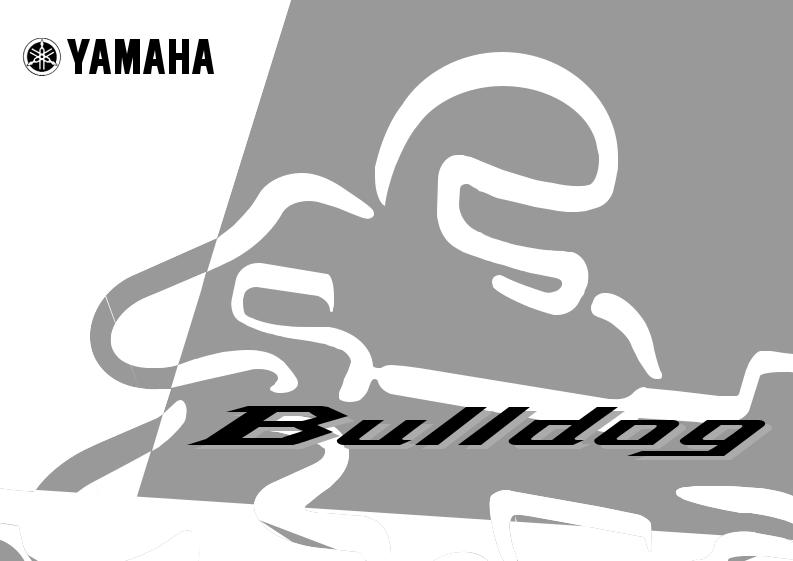
USO E MANUTENZIONE
OWNER’S MANUAL
MANUEL DU PROPRIÉTAIRE BEDIENUNGSANLEITUNG MANUAL DEL PROPIETARIO
BT1100
5JN-F8199-A0

EAU03338 |
INTRODUCTION |
|
Welcome to the Yamaha world of motorcycling!
As the owner of a BT1100, you are benefiting from Yamaha’s vast experience and newest technology regarding the design and manufacture of high-quality products, which have earned Yamaha a reputation for dependability.
Please take the time to read this manual thoroughly, so as to enjoy all advantages of your BT1100. The owner’s manual does not only instruct you in how to operate, inspect and maintain your motorcycle, but also in how to safeguard yourself and others from trouble and injury.
In addition, the many tips given in this manual will help keep your motorcycle in the best possible condition. If you have any further questions, do not hesitate to contact your Yamaha dealer.
The Yamaha team wishes you many safe and pleasant rides. So, remember to put safety first!
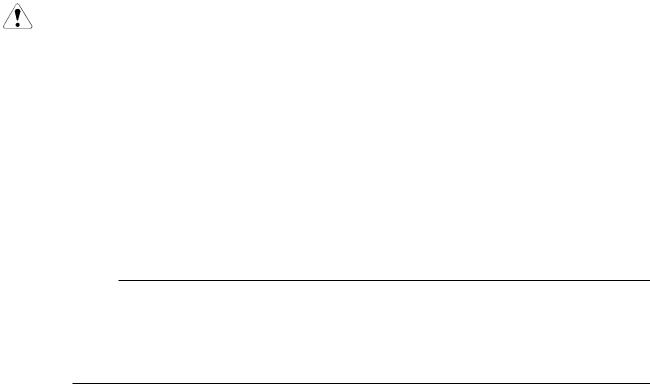
IMPORTANT MANUAL INFORMATION |
EAU00005 |
|
|
|
|
Particularly important information is distinguished in this manual by the following notations:
|
|
The Safety Alert Symbol means ATTENTION! BECOME ALERT! YOUR SAFETY IS INVOLVED! |
|
|
|
|
|
|
|
|
Failure to follow WARNING instructions could result in severe injury or death to the |
|
WARNING |
|
|
|
motorcycle operator, a bystander, or a person inspecting or repairing the motorcycle. |
|
|
|
|
|
|
|
|
A CAUTION indicates special precautions that must be taken to avoid damage to the |
|
CAUTION: |
|
|
motorcycle. |
|
|
|
|
|
|
|
|
|
|
NOTE |
A NOTE provides key information to make procedures easier or clearer. |
|
|
|
|
NOTE:
•This manual should be considered a permanent part of this motorcycle and should remain with it even if the motorcycle is subsequently sold.
•Yamaha continually seeks advancements in product design and quality. Therefore, while this manual contains the most current product information available at the time of printing, there may be minor discrepancies between your motorcycle and this manual. If you have any questions concerning this manual, please consult your Yamaha dealer.

EAU00005 |
IMPORTANT MANUAL INFORMATION |
|
EW000002
WARNING0
PLEASE READ THIS MANUAL CAREFULLY AND COMPLETELY BEFORE OPERATING THIS MOTORCYCLE.

EAUBOOOO
BT1100
OWNER’S MANUAL 2001 by Belgarda S.p.A. 1st edition, july 2001 All rights reserved.
Any reprinting or unauthorized use without the written permission of Belgarda S.p.A.
is expressly prohibited. Printed in Italy.

EAU00009 |
TABLE OF CONTENTS |
|
GIVE SAFETY THE RIGHT OF WAY |
|
1 |
|
|
|
|
|
|
DESCRIPTION |
|
2 |
|
|
|
|
|
|
INSTRUMENT AND CONTROL FUNCTIONS |
|
3 |
|
|
|
|
|
|
PRE-OPERATION CHECKS |
|
4 |
|
|
|
|
|
|
OPERATION AND IMPORTANT RIDING POINTS |
|
5 |
|
|
|
|
|
|
PERIODIC MAINTENANCE AND MINOR REPAIR |
|
6 |
|
|
|
|
|
|
MOTORCYCLE CARE AND STORAGE |
|
7 |
|
|
|
|
|
|
SPECIFICATIONS |
|
8 |
|
|
|
|
|
|
CONSUMER INFORMATION |
|
9 |
|
|
|
INDEX

EAU00021 |
GIVE SAFETY THE RIGHT OF WAY |
|
|
||
|
|
|
|
Give safety the right of way ................................................................ |
1-1 |
1

 GIVE SAFETY THE RIGHT OF WAY
GIVE SAFETY THE RIGHT OF WAY
EAU00021
EW000015
|
Motorcycles are fascinating vehicles, which can give you an unsurpassed feeling of power and freedom. Howev- |
|
er, they also impose certain limits, which you must accept; even the best motorcycle does not ignore the laws of |
1 |
physics. |
Regular care and maintenance are essential for preserving value and operating condition of your motorcycle. Moreover, what is true for the motorcycle is also true for the rider: good performance depends on being in good shape. Riding under the influence of medication, drugs and alcohol is, of course, out of the question. Motorcycle riders––more than car drivers––must always be at their mental and physical best. Under the influence of even small amounts of alcohol, there is a tendency to take dangerous risks.
Protective clothing is as essential for the motorcycle rider as seat belts are for car drivers and passengers. Always wear a complete motorcycle suit (whether made of leather or tear-resistant synthetic materials with protectors), sturdy boots, motorcycle gloves and a properly fitting helmet. Optimum protective wear, however, should not encourage carelessness. Although full-coverage helmets and suits, in particular, create an illusion of total safety and protection, motorcyclists will always be vulnerable. Riders who lack critical self-control run the risk of going too fast and are apt to take chances. This is even more dangerous in wet weather. The good motorcyclist rides safely, predictably and defensively––avoiding all dangers, including those caused by others.
Enjoy your ride!
1-1

EAU00026 |
DESCRIPTION |
|
|
|
|
Left view................................................................................................ |
2-1 |
Right view ............................................................................................ |
2-2 |
Controls and instruments ...................................................................... |
2-3 |
2
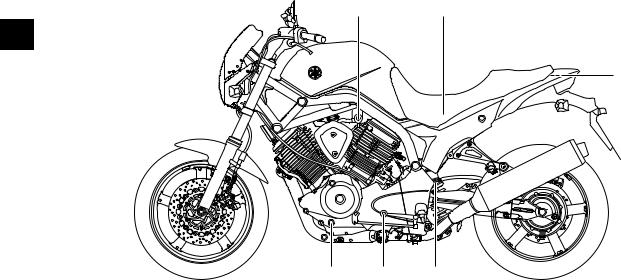
DESCRIPTION |
EAU00026 |
|
|
|
|
Left view
1 2
2
3
|
6 |
5 |
4 |
1. |
Starter (choke) lever |
|
(page 3-12) |
2. |
Storage compartment |
|
(page 3-14) |
3. Tool kit |
|
(page 6-1) |
|
4. |
Spring preload adjusting ring (shock absorber assembly) |
|
(page 3-15) |
5. |
Shift pedal |
|
(page 3-10) |
6. |
Engine oil level window |
|
(page 6-6) |
2-1
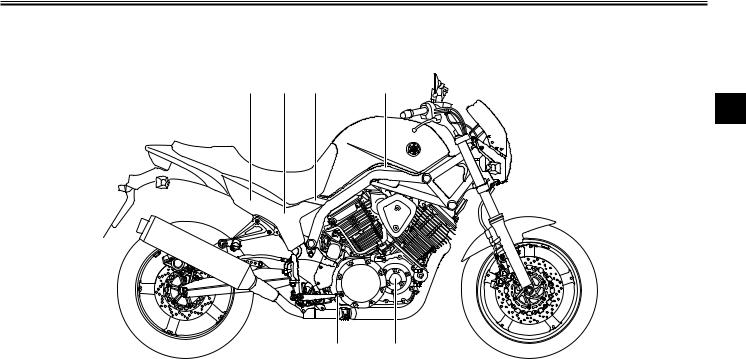
EAU00026
Right view
DESCRIPTION
7 |
8 |
9 |
10 |
2
|
12 |
11 |
7. |
Fuse box |
(page 6-28) |
8. |
Battery |
(page 6-26) |
9. |
Helmet holders |
(page 3-14) |
10. Air filter element |
(page 6-10) |
|
11. Engine oil filter element |
(page 6-6) |
|
12. Brake pedal |
(page 3-10) |
|
2-2
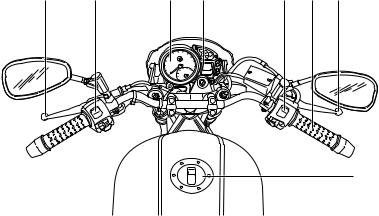
DESCRIPTION |
EAU00026 |
|
|
|
|
Controls and instruments
2 |
1 |
2 |
3 |
4 |
5 |
6 |
7 |
|
|
|
|
|
|
|
|
|
|
|
|
|
|
|
|
80 60
120 140
100160
180
200
40
20
|
|
220 |
4 |
5 |
6 |
3 |
|
7 |
2 1
0
8
1. |
Clutch lever |
(page 3-9) |
2. |
Left handlebar switches |
(page 3-8) |
3. |
Instruments and warning lights |
(page 3-2) |
4. |
Main switch and steering lock |
(page 3-1) |
5. |
Right handlebar switches |
(page 3-9) |
6. Throttle grip |
(page 6-13) |
|
7. |
Front brake lever |
(page 3-10) |
8. |
Fuel tank cap |
(page 3-11) |
2-3
|
EAU00027 |
INSTRUMENT AND CONTROL FUNCTIONS |
|
|||
|
|
|
||||
|
|
|
|
|
|
|
|
|
|
|
|
|
|
|
|
|
Main switch/steering lock .................................................................... |
3-1 |
|
|
|
|
|
Indicator and warning lights ................................................................ |
3-2 |
|
|
|
|
|
Speedometer unit ................................................................................ |
3-3 |
|
|
|
|
|
Tachometer ........................................................................................ |
3-6 |
|
|
|
|
|
Self-diagnosis device .......................................................................... |
3-6 |
|
|
|
|
|
Anti-theft alarm (optional) |
3-8 |
|
|
|
|
3 |
||||
|
|
|
Handlebar switches |
3-8 |
|
|
|
|
|
|
|
||
|
|
|
........................................................................................Clutch lever |
3-9 |
|
|
|
|
|
Shift pedal ........................................................................................ |
3-10 |
|
|
|
|
|
Brake lever ........................................................................................ |
3-10 |
|
|
|
|
|
Brake pedal ...................................................................................... |
3-10 |
|
|
|
|
|
Fuel tank cap .................................................................................... |
3-11 |
|
|
|
|
|
Fuel .................................................................................................. |
3-11 |
|
|
|
|
|
Fuel tank breather hose .................................................................... |
3-12 |
|
|
|
|
|
Starter (choke) lever ........................................................................ |
3-12 |
|
|
|
|
|
Seat .................................................................................................. |
3-13 |
|
|
|
|
|
Helmet holders .................................................................................. |
3-14 |
|
|
|
|
|
Storage compartment ...................................................................... |
3-14 |
|
|
|
|
|
Adjusting the front fork ...................................................................... |
3-15 |
|
|
|
|
|
Adjusting the shock absorber assembly .......................................... |
3-15 |
|
|
|
|
|
Sidestand .......................................................................................... |
3-16 |
|
|
|
|
|
Ignition circuit cut-off system ............................................................ |
3-17 |
|
|
|
|
|
|
|
|
|
|
|
|
|
|
|
|
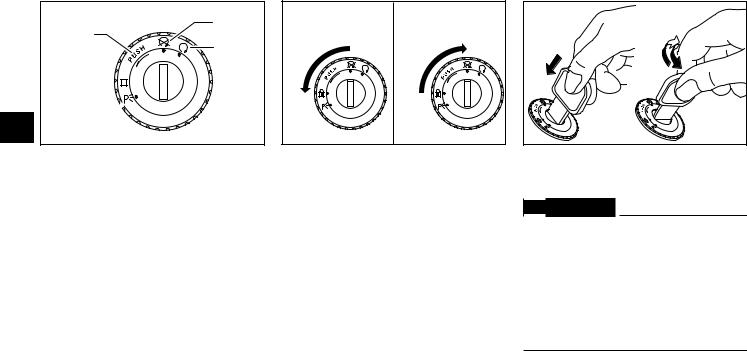
INSTRUMENT AND CONTROL FUNCTIONS |
EAU00027 |
|
|
|
|
OFF
PUSH
ON
LOCK 



P
3
EAU00029
Main switch/steering lock
The main switch/steering lock controls the ignition and lighting systems, and is used to lock the steering. The various positions are described below.
EAU00036
I ON
All electrical systems are supplied with power, and the engine can be started. The key cannot be removed.
EAU00038
B OFF
All electrical systems are off. The key can be removed.
|
|
Lock |
|
|
Unlock |
|
|||
|
|
Bloccare |
|
|
Sbloccare |
|
|||
|
|
|
|
|
|
|
|
|
|
|
OFF |
|
|
|
OFF |
||||
(Premere)push) |
|||||||||
|
|
|
|
|
|
|
|
|
|
LOCK
LOCK
(push)
EAU00040
DLOCK
The steering is locked, and all electrical systems are off. The key can be removed.
To lock the steering
1.Turn the handlebars all the way to the left.
2.Push the key in from the B(OFF) position, and then turn it to D (LOCK) while still pushing it.
3.Remove the key.
To unlock the steering
Push the key in, and then turn it to B (OFF) while still pushing it.
1 |
2 |
1.Push
2.Turn
EW000016
WARNING0
Never turn the key to B (OFF) or D
(LOCK) while the motorcycle is moving, otherwise the electrical systems will be switched off, which may result in loss of control or an accident. Make sure that the motorcycle is stopped before turning the key to B (OFF) or D
(LOCK).
3-1
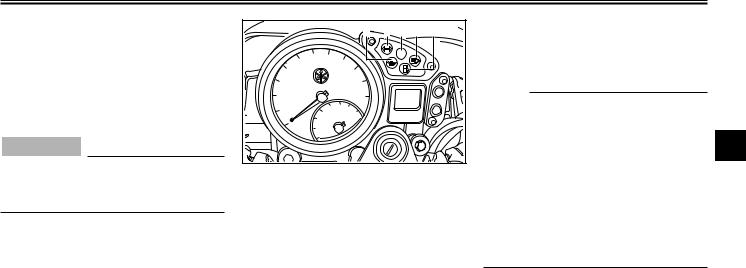
EAU00027 |
INSTRUMENT AND CONTROL FUNCTIONS |
|
EAU01590
F (Parking)
The steering is locked, and the taillight and auxiliary light are on, but all other electrical systems are off. The key can be removed. The steering must be locked before the key can be turned to “F” .
ECA00043
CAUTION:
Do not use the parking position for an extended length of time, otherwise the battery may discharge.
|
|
|
1 |
2 3 4 |
5 |
120 140 |
|
|
N |
|
|
100 |
160 |
|
|
||
80 |
|
|
180 |
|
|
60 |
|
|
200 |
|
|
|
|
|
|
|
|
40 |
|
|
220 |
|
|
20 |
4 |
5 |
6 |
|
|
|
|
|
|||
|
3 |
|
7 |
|
|
km/h |
2 |
|
|
|
|
|
1 |
|
|
|
|
|
0 |
|
|
|
|
1.Oil level warning light “v”
2.Turn signal indicator light “y”
3.Neutral indicator light “N”
4.High beam indicator light “1”
5.Fuel level warning light “K”
EAU03034
2.If the warning light does not come on, have a Yamaha dealer check the electrical circuit.
NOTE:
Even if the oil level is sufficient, the warning light may flicker when riding on a slope or during sudden acceleration or decelera-
tion, but this is not a malfunction. |
3 |
||
|
|||
|
|
|
|
NOTE: |
|
|
|
This model is equipped with a self-diagno- |
|
||
sis device for the oil level warning light cir- |
|
||
cuit. (See page 3-6 for an explanation of |
|
||
the self-diagnosis device). |
|
||
Indicator and warning lights
EAUB0001
Oil level warning light “v”
This warning light comes on when the engine oil level is low.
The electrical circuit of the warning light can be checked according to the following procedure.
1.Turn the key to “I” (ON). The warning light should come on for a few seconds.
EAU00057
Turn signal indicator light “y”
This indicator light flashes when the turn signal switch is pushed to the left or right.
EAU00061
Neutral indicator light “N”
This indicator light comes on when the transmission is in the neutral position.
3-2
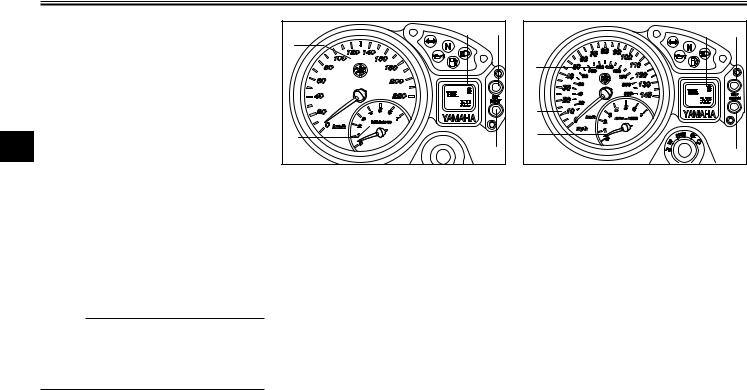
|
INSTRUMENT AND CONTROL FUNCTIONS |
|
EAU00027 |
||
|
|
|
|||
|
EAU00063 |
3 |
4 |
4 |
5 |
|
High beam indicator light “1” |
||||
|
1 |
|
|
|
|
|
This indicator light comes on when the |
|
|
|
|
|
|
|
1 |
|
|
|
high beam of the headlight is switched on. |
|
|
|
|
|
|
|
|
|
|
|
EAUB0002 |
|
|
|
|
|
Fuel level warning light “K” |
|
|
2 |
|
|
This warning light comes on when the fuel |
|
|
|
|
|
|
|
3 |
|
|
3 |
level drops below approximately 5.8 L. |
2 |
|
|
|
When this occurs, refuel as soon as possi- |
|
5 |
|
6 |
|
|
|
|
|||
|
ble. |
1. Speedometer set to km/h |
|
1. Speedometer set to km/h |
|
|
The electrical circuit of the warning light |
|
|
||
|
2. Tachometer |
|
2. Speedometer set to mph |
|
|
|
can be checked according to the following |
|
|
||
|
3. Odometer/ tripmeter/ fuel reserve tripmeter/ |
3. Tachometer |
|
||
|
procedure. |
clock display |
|
4. Odometer/ tripmeter/ fuel reserve tripmeter/ |
|
|
1. Turn the key to “I” (ON). |
4. “SET” button |
|
clock display |
|
|
5. “RESET” button |
|
5. “SET” button |
|
|
|
2. If the warning light does not come on, |
|
|
||
|
|
|
6. “RESET” button |
|
|
|
have a Yamaha dealer check the |
|
EAUB0003 |
|
|
|
electrical circuit. |
Speedometer unit |
|
|
|
NOTE:
This model is equipped with a self-diagno- sis device for the fuel level warning light circuit. (See page 3-6 for an explanation of the self-diagnosis device).
The speedometer unit is equipped with the following:
•a speedometer (which shows riding speed)
•a tachometer (which shows engine r/min)
•an odometer (which shows the total distance traveled)
•two tripmeters (which show the distance traveled since they were last set to zero)
•a fuel reserve tripmeter (which shows the distance traveled on the fuel reserve)
•an oil change indicator (which is displayed when the oil needs to be changed)
•a clock.
3-3
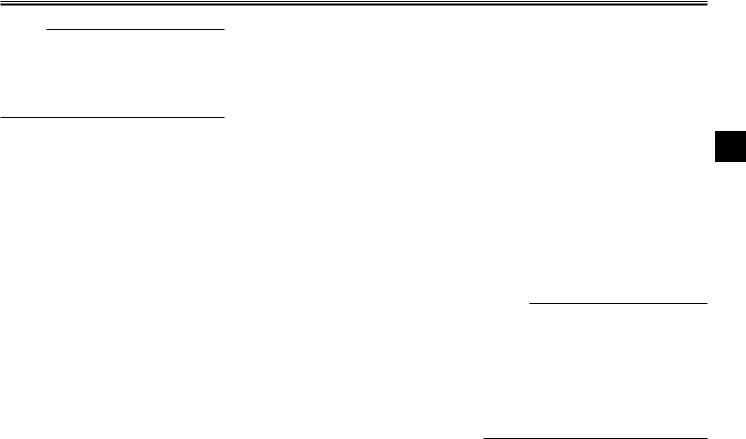
EAU00027 |
INSTRUMENT AND CONTROL FUNCTIONS |
|
NOTE:
Depending on the market where the motorcycle is sold, the speedometer can be set to either mph or km/h. When the speedometer is set to mph, the odometer counts in miles (1 mile = 1.61 km).
Odometer and tripmeter modes
Pushing the “SET” button switches the display between the odometer mode “ODO” and the tripmeter modes “TRIP 1” and “TRIP 2” in the following order: ODO 6 TRIP 1 6 TRIP 2 6 ODO
When the fuel warning light comes on, the display will automatically change to the fuel reserve tripmeter mode “TRIP F” and start counting the distance traveled from that point. In that case, pushing the “SET” button switches the display between the various tripmeter and odometer modes in the following order: TRIP F 6 TRIP 1 6 TRIP 2 6 ODO 6 TRIP F
To reset a tripmeter, select it by pushing the “SET” button, and then push the “RESET” button for at least one second. If you do not reset the fuel reserve tripmeter manually, it will reset itself automatically and the display will return to the prior mode after refueling and traveling several kilometers.
Oil change indicator
At the initial 1,000 km (620 mi) and every 10,000 km (6,200 mi) thereafter, the message “OIL CHANGE” appears in the display for a few seconds when the key is turned to “ON”, to indicate that the engine oil should be changed.
After changing the engine oil, reset the oil
3
change indicator.
If the engine oil is changed before the oil change indicator appears in the display (i.e. before the periodic oil change interval has been reached), the indicator must be reset after the oil change for the next periodic oil change to be indicated at the correct time.
NOTE:
When the message “OIL CHANGE” appears in the display, be sure to change the engine oil as soon as possible. In addition to these kilometer-based oil changes, be sure to have a Yamaha dealer perform the annual checks specified in the periodic maintenance and lubrication chart on page 6-2.
3-4

INSTRUMENT AND CONTROL FUNCTIONS |
EAU00027 |
|
|
|
|
To reset the periodic maintenance and lubrication indicator:
1.Turn the key to “B” (OFF).
2.Push the “RESET” button and hold it down while turning the key to “I” (ON).
3
Clock mode
NOTE:
The clock can only be set while the speedometer unit is in the odometer mode.
To set the clock:
1.Turn the key to “I” (ON).
2.Push the “RESET” button and “SET” button together for at least two seconds.
3.When the hour digits start flashing, push the “RESET” button to set the hours (between 1 and 12).
4.Push the “SET” button, and the first of the two minute digits will start flashing.
5.Push the “RESET” button to set the first minute digit (between 0 and 5).
6.Push the “SET” button, and the second of the two minute digits will start flashing.
7.Push the “RESET” button to set the second minute digit (between 0 and 9).
8.Push the “SET” button, and then release it to start the clock.
3-5
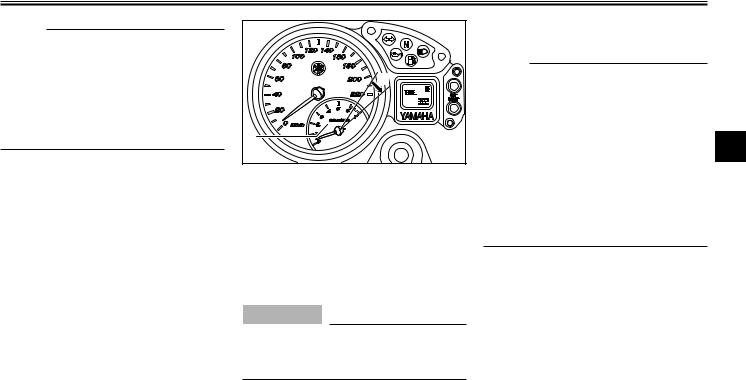
EAU00027 |
INSTRUMENT AND CONTROL FUNCTIONS |
|
NOTE:
The clock can only be set when the motorcycle is stopped. The clock does not automatically adjust for Daylight Saving Time. Therefore, when the time changes from Standard Time to Daylight Saving Time (and vice versa), the clock must be set manually.
2 |
1 |
1.Tachometer
2.Red zone
EAU00101
Tachometer
The electric tachometer allows the rider to monitor the engine speed and keep it within the ideal power range.
EC000003
CAUTION:
Do not operate the engine in the tachometer red zone.
Red zone: 6,400 r/min and above.
EAUB0004
Self-diagnosis device
NOTE:
When the key is turned to “I” (ON), the tachometer and speedometer needles should move to the maximum, then back to zero. In addition, the oil level warning
light and fuel level warning light should
3
come on for a few seconds, then go off. If the tachometer or speedometer needle does not move as described or either of the warning lights does not come on, have a Yamaha dealer check the electrical circuits.
This model is equipped with a self-diagno- sis device for the following electrical circuits:
•speedometer
•tachometer
•oil level warning light
•throttle position sensor
•speed sensor.
3-6

INSTRUMENT AND CONTROL FUNCTIONS |
EAU00027 |
|
|
|
|
If any of the above circuits are defective, the tachometer will repeatedly display the following error code:
0 r/min (for 3 seconds)
3
Circuit-specific number of r/min for 2.5 seconds (see the table below).
Current engine speed for 3 seconds
Use the chart below to identify the faulty electrical circuit.
Specific |
Faulty electrical |
r/min |
circuit |
|
|
3,000 r/min |
Throttle position |
|
sensor |
|
|
4,000 r/min |
Speed sensor |
|
|
If the tachometer displays such an error code, note the circuit-specific number of r/min, and then have a Yamaha dealer check the motorcycle.
EC000004
CAUTION:
When the tachometer displays an error code, the motorcycle should be checked as soon as possible in order to avoid engine damage.
3-7

EAU00027 |
INSTRUMENT AND CONTROL FUNCTIONS |
|
EAU00109
Anti-theft alarm (optional)
This motorcycle can be equipped with an optional anti-theft alarm by a Yamaha dealer. Contact a Yamaha dealer for more information.
|
EAU00119 |
|
3 |
Pass switch “1” |
|
2 |
Press this switch to flash the headlight. |
|
EAU00121 |
|
|
|
|
|
|
Dimmer switch “2/ 1” |
|
4 |
Set this switch to “1” for the high beam |
|
and to “2” for the low beam. |
|
|
1 |
|
|
|
EAU00129 |
3 |
|
Horn switch “o” |
|
|
|
|
1. Turn signal switch “y” |
Press this switch to sound the horn. |
|
|
|
|
2. Pass switch “1” |
|
|
3. Dimmer switch “2/ 1” |
|
|
4. Horn switch “o” |
|
|
EAU00118
Handlebar switches
EAU03889
Turn signal switch “y”
To signal a right-hand turn, push this switch to “∆”. To signal a left-hand turn, push this switch to “Ÿ”. When released, the switch returns to the center position. To cancel the turn signal lights, push the switch in after it has returned to the center position.
3-8
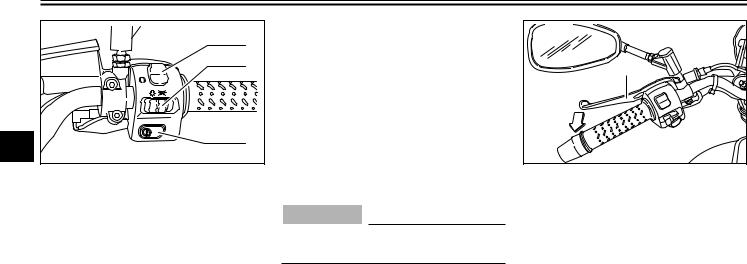
|
INSTRUMENT AND CONTROL FUNCTIONS |
EAU00027 |
||
|
|
|||
|
|
|
EAU03898 |
|
|
|
1 |
Light switch “G/E/H” |
|
|
|
Set this switch to “G” to turn on the aux- |
|
|
|
|
2 |
1 |
|
|
|
iliary light, meter lighting and taillight. Set |
||
|
|
|
|
|
|
|
|
the switch to “E” to turn on the headlight |
|
|
|
|
also. Set the switch to “H” to turn off all the |
|
|
|
|
lights. |
|
3 |
|
3 |
EAU00143 |
|
|
Start switch “J” |
|
||
|
|
|
|
|
|
1. Engine stop switch “I/B” |
|
Push this switch to crank the engine with |
1. Clutch lever |
|
|
the starter. |
||
|
2. Light switch “G/E/H” |
|
|
|
|
|
|
|
|
|
3. Start switch “J” |
|
EC000005 |
|
|
|
CAUTION: |
|
|
|
|
|
|
|
EAU03890
Engine stop switch “I/B”
Set this switch to “I” before starting the engine. Set this switch to “B” to stop the engine in case of an emergency, such as when the motorcycle overturns or when the throttle cable is stuck.
See page 5-1 for starting instructions prior to starting the engine.
EAU00152
Clutch lever
The clutch lever is located at the left handlebar grip. To disengage the clutch, pull the lever toward the handlebar grip. To engage the clutch, release the lever. The lever should be pulled rapidly and released slowly for smooth clutch operation. The clutch lever is equipped with a clutch switch, which is part of the ignition circuit cut-off system. (See page 3-18 for an explanation of the ignition circuit cut-off system).
3-9

EAU00027 |
INSTRUMENT AND CONTROL FUNCTIONS |
|
|||
|
|
||||
|
|
|
2 |
3 |
|
|
|
|
|
|
|
|
|
|
1 |
4 |
|
|
|
|
|
|
|
|
1 |
|
|
3 |
|
|
1 |
2 |
|
1 |
3 |
|
|
|
|||
1. Shift pedal
EAU00157
Shift pedal
The shift pedal is located on the left side of the engine and is used in combination with the clutch lever when shifting the gears of the 5-speed constant-mesh transmission equipped on this motorcycle.
1.Brake lever
2.Position adjusting dial
3.Arrow mark
EAU00161
Brake lever
The brake lever is located at the right handlebar grip. To apply the front brake, pull the lever toward the handlebar grip.
The brake lever is equipped with a position adjusting dial. To adjust the distance between the brake lever and the handlebar grip, turn the adjusting dial while holding the lever pushed away from the handlebar grip. Make sure that the appropriate setting on the adjusting dial is aligned with the arrow mark on the brake lever.
1. Brake pedal
EAU00162
Brake pedal
The brake pedal is on the right side of the motorcycle. To apply the rear brake, press down on the brake pedal.
3-10
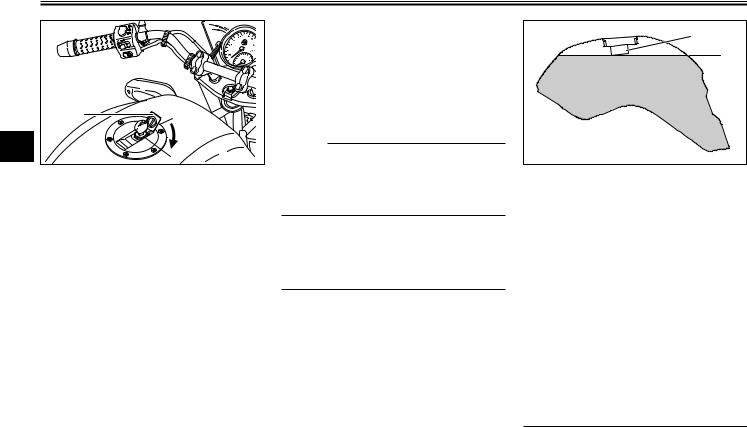
|
INSTRUMENT AND CONTROL FUNCTIONS |
EAU00027 |
||
|
|
|||
|
|
|
To close the fuel tank cap |
1 |
|
|
|
1. Push the fuel tank cap into position |
|
|
|
|
2 |
|
|
|
|
with the key inserted in the lock. |
|
|
|
|
2. Turn the key counterclockwise to the |
|
|
|
|
original position, remove it, and then |
|
|
1 |
|
close the lock cover. |
|
|
|
|
|
|
3 |
|
2 |
NOTE: |
|
|
|
|
||
|
|
The fuel tank cap cannot be closed unless |
|
|
|
|
|
|
|
|
1. Lock cover |
|
the key is in the lock. In addition, the key |
1. Fuel tank filler tube |
|
|
cannot be removed if the cap is not prop- |
||
|
2. Open |
|
2. Fuel level |
|
|
|
erly closed and locked. |
||
|
|
|
|
|
EAU02935
Fuel tank cap
To open the fuel tank cap
Open the fuel tank cap lock cover, insert the key into the lock, and then turn it 1/4 turn clockwise. The lock will be released and the fuel tank cap can be opened.
|
WARNING0 |
|
EWA00025 |
|
|
|
|
|
|
|
|
Make sure that the fuel tank cap is properly closed before riding.
EAU03753
Fuel
Make sure that there is sufficient fuel in the tank. Fill the fuel tank to the bottom of the filler tube as shown.
|
|
WARNING0 |
|
EW000130 |
|
|
|
|
•Do not overfill the fuel tank, otherwise it may overflow when the fuel warms up and expands.
•Avoid spilling fuel on the hot engine.
3-11
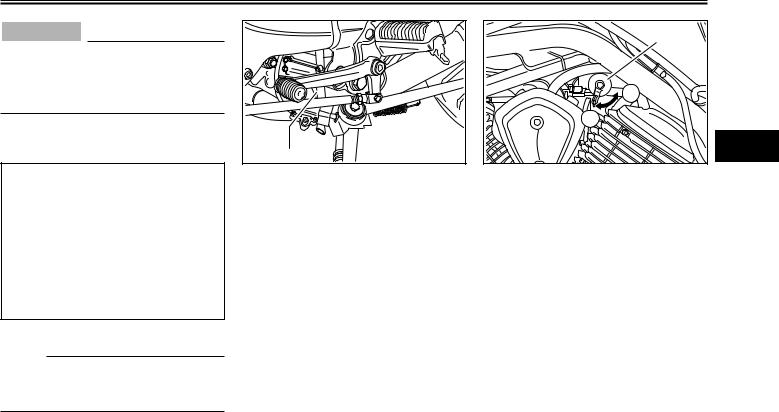
EAU00027 |
INSTRUMENT AND CONTROL FUNCTIONS |
|
EAU00185
CAUTION:
Immediately wipe off spilled fuel with a clean, dry, soft cloth, since fuel may deteriorate painted surfaces or plastic parts.
EAU00191
Recommended fuel:
Regular unleaded gasoline with a research octane number of 91 or higher
Fuel tank capacity: Total amount:
20 L Reserve amount:
5.8 L
NOTE:
If knocking (or pinging) occurs, use gasoline of a different brand or with a higher octane grade.
1 |
1. Fuel tank breather hose
EAU02955
Fuel tank breather hose
Before operating the motorcycle:
Check the fuel tank breather hose connection.
Check the fuel tank breather hose for cracks or damage, and replace it if damaged.
Make sure that the end of the fuel tank breather hose is not blocked, and clean it if necessary.
1 |
b |
a |
3 |
1. Starter (choke) lever
EAU03839
Starter (choke) lever
Starting a cold engine requires a richer airfuel mixture, which is supplied by the starter (choke).
Move the lever in direction b to turn on the starter (choke).
Move the lever in direction a to turn off the starter (choke).
3-12
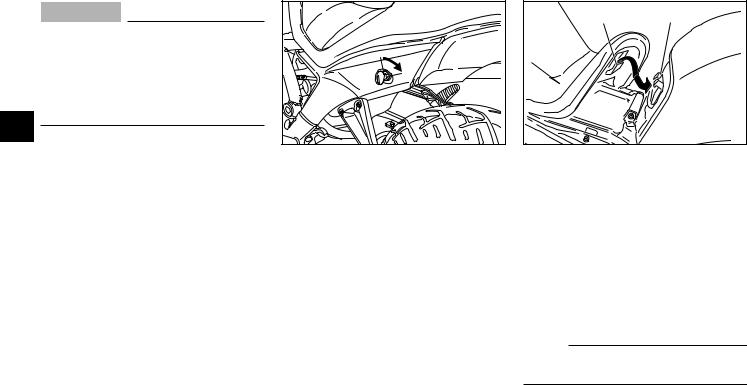
INSTRUMENT AND CONTROL FUNCTIONS |
EAU00027 |
|
|
|
|
ECA00038
CAUTION:
Do not use the starter (choke) for more than 3 minutes as the exeaust pipe may discolor from excessive heat. In addition, extended use of the starter (choke) will cause afterburning. If this
occurs, turn off the starter (choke).
3
1 |
1. Open
EAU01726
Seat
To remove the seat
1.Insert the key into the seat lock, and then turn it clockwise.
2.Pull the seat off.
12
1.Projection
2.Seat holder
To install the seat
1.Insert the projections on the front of the seat into the seat holders as shown.
2.Push the rear of the seat down to lock it in place.
3.Remove the key.
NOTE:
Make sure that the seat is properly secured before riding.
3-13
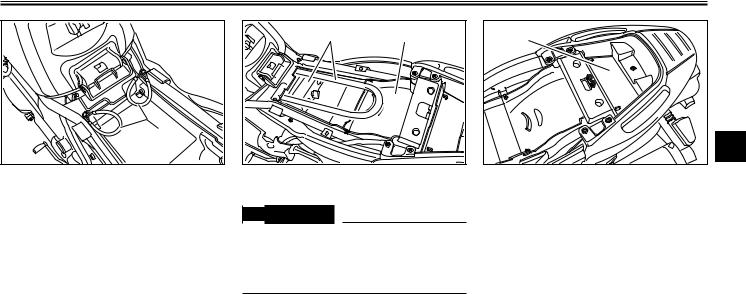
EAU00027 |
INSTRUMENT AND CONTROL FUNCTIONS |
||
|
|||
|
2 |
1 |
1 |
|
1 |
|
3 |
|
|
|
|
1. Helmet holders
EAUB0005
Helmet holders
The helmet holders are located under the seat. Each of the two helmet-holding cables provided can be used to secure a helmet to either helmet holder
To secure a helmet to a helmet holder
1.Remove the seat. (See page 3-13 for removal and installation procedures).
2.Pass the helmet holding cable through the buckle on the helmet strap as shown, and then hook the cable loop over the helmet holder.
3.Install the seat.
1.Storage compartment
2.Yamaha U-LOCK
EWA00015
WARNING0
Never ride with a helmet attached to a helmet holder, since the helmet may hit objects, causing loss of control and possibly an accident.
EAUB0006
Storage compartment
The storage compartment is located under the seat. (See page 3-13 for seat removal and installation procedures).
This storage compartment is designed to hold a genuine Yamaha U-LOCK. (Other locks may not fit).
1. Tool kit compartment
The tool kit is located at the back of the storage compartment and held in place with a strap.
When storing the owner’s manual or other documents in the storage compartment, be sure to wrap them in a plastic bag so that they will not get wet. When washing the motorcycle, be careful not to let any water enter the storage compartment.
3-14
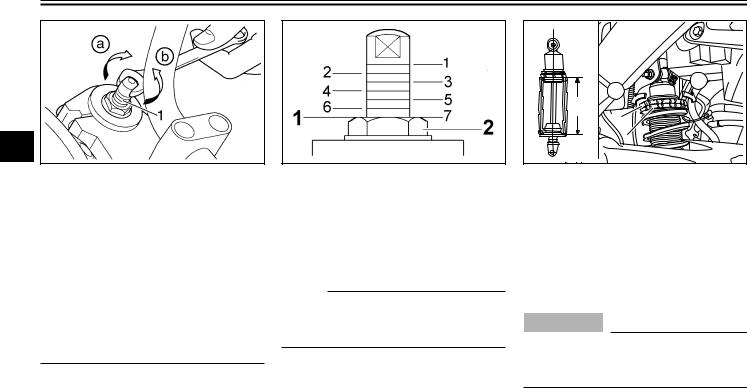
INSTRUMENT AND CONTROL FUNCTIONS |
|
|
EAU00027 |
|
|
|
|
|
|
a |
b |
|
A |
|
|
|
2 |
|
|
|
|
|
|
3 |
|
1 |
|
|
|
|
1. Spring preload adjusting bolt
EAU00285
Adjusting the front fork
This front fork is equipped with spring preload adjusting bolts.
|
WARNING0 |
|
EW000035 |
|
|
|
|
|
|
|
|
Always adjust both fork legs equally, otherwise poor handling and loss of stability may result.
Adjust the spring preload as follows.
To increase the spring preload and thereby harden the suspension, turn the adjusting bolt on each fork leg in direction a. To de-
1.Setting
2.Front fork cap bolt
crease the spring preload and thereby soften the suspension, turn the adjusting bolt on each fork leg in direction b.
NOTE:
Align the appropriate groove on the adjusting mechanism with the top of the front fork cap bolt.
|
Minimum (soft) |
Standard |
Maximum (hard) |
||||
|
|
|
|
|
|
|
|
Setting |
1 |
2 |
3 |
4 |
5 |
6 |
7 |
|
|
|
|
|
|
|
|
1.Spring preload adjusting nut
2.Locknut
EAUB0007
Adjusting the shock absorber assembly
This shock absorber assembly is equipped with a spring preload adjusting nut.
EC000015
CAUTION:
Never attempt to turn an adjusting mechanism beyond the maximum or minimum settings.
Adjust the spring preload as follows.
1.Loosen the locknut.
2.To increase the spring preload and
thereby harden the suspension, turn the adjusting nut in direction a. To
3-15
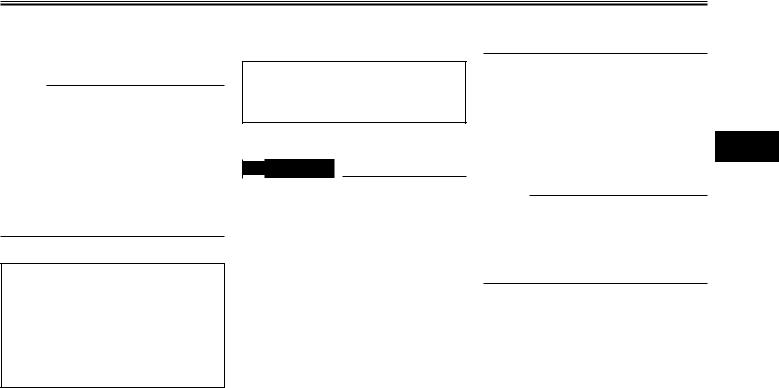
EAU00027 |
INSTRUMENT AND CONTROL FUNCTIONS |
|
decrease the spring preload and thereby soften the suspension, turn the adjusting nut in direction b.
NOTE:
Use the special wrench included in the owner’s tool kit to make the adjustment. The spring preload setting is determined by measuring distance A, shown in the illustration. The longer distance A is, the higher the spring preload; the shorter distance A is, the lower the spring preload. With each complete turn of the adjusting nut, distance A changes by 1.5 mm.
Spring preload:
Minimum (soft):
Distance A = 170 mm
Standard:
Distance A = 162 mm
Maximum (hard):
Distance A = 154 mm
3.Tighten the locknut to the specified torque.
Tightening torque: Locknut:
45 Nm (4.5 m•kg)
EAU00315
WARNING0
This shock absorber contains highly pressurized nitrogen gas. For proper handling, read and understand the following information before handling the shock absorber. The manufacturer cannot be held responsible for property damage or personal injury that may result from improper handling.
•Do not tamper with or attempt to open the gas cylinder.
•Do not subject the shock absorber to an open flame or other high heat sources, otherwise it may explode due to excessive gas pressure.
•Do not deform or damage the gas cylinder in any way, as this will result in poor damping performance.
•Always have a Yamaha dealer service the shock absorber.
EAU00330
Sidestand
The sidestand is located on the left side of the frame. Raise the sidestand or lower it
with your foot while holding the motorcycle 3 upright.
NOTE:
The built-in sidestand switch is part of the ignition circuit cut-off system, which cuts the ignition in certain situations. (See further down for an explanation of the ignition circuit cut-off system).
3-16
